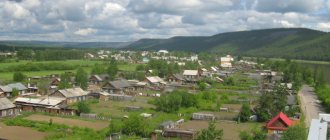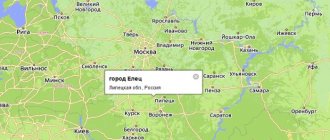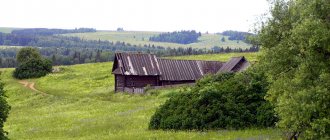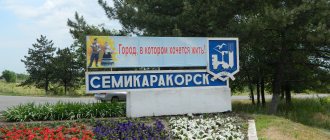Content
- 1 19th century
- 2 After 1917
- 3 20-30 years
- 4 1941-45
- 5 50s 5.1 Demographics of Yelets
The town of Yelets is “the golden heritage of our ancestors.” In our time, the topic of historical research into small towns in Russia is very relevant, because it is in the outback of Russia, in its heart, that the “golden heritage of our ancestors” is located.
Yelets has stood on the banks of the Bystraya Sosna River for a thousand years. Founded presumably in 986 under the Kiev prince Vladimir Svyatoslavovich, the city as an existing one was first mentioned in the Nikon Chronicle for 1146: “Prince Svyatoslav Olgovich went to Rezan and was in Mchensk, and in Tula, and in Yelets, and in Pronsk and came to Rezan on the Oka.”
The situation on the south-eastern outskirts of the Russian lands, on the border with the “Wild Field”, determined the fate of the city for several centuries: “it was...protection of the land of Rustei.” The raids of the Polovtsians, the invasions of the Tatar-Mongols, the invasion of the Crimean and Horde hordes more than once led the city to desolation, but it was rebuilt and rose again.
Who has the Yelets fortress seen under its walls for many centuries! How many times did the alarm bell ring on its watchtower to alarm the area before the enemy arrived!
I.A. Bunin, who studied at the Yelets gymnasium, wrote about Yelets: “the city was also proud of its antiquity and had every right to be so: it was indeed one of the most ancient Russian cities, lying among the great black earth fields of the Substeppe on that fateful line, behind which “wild, unknown lands” once stretched, and during the time of the principalities of Suzdal and Ryazan it belonged to those most important strongholds of Russia that, according to the word and deed of those who came over it, the first to see the glow of the terrible night and day fires they set on fire, the first to let know Moscow about the coming trouble and were the first to lay down their bones for it.”
From the middle of the 17th century, Yelets developed as a city of artisans and traders. Carts with grain, herds of cattle, carts with leather and saddlery goods are heading to Tula and Moscow, to the distant Nizhny Novgorod fair. The unfading skill of Yelets lacemakers brought him particular fame. Yelets is the only city in the Lipetsk region included in the list of cities in the Russian Federation that have valuable monuments of culture, history and architecture. Together with Tula and Yasnaya Polyana, Mtsensk and Spassky-Lutovinov, Orel, Livny, Kulikov chroniclers, the first inhaled the storm, dust and cold from under the menacing Asian clouds, then the field, Pronsk and Ryazan, it can become the pearl of the tourist Silver Ring of Russia. Here, at the crossroads of roads and railways, there are all the conditions for this: an excellent local history museum, the famous lace industry, a magnificent landscape, interesting corners of nature.
The increasing flow of tourists is attracting increasing attention to the cultural and artistic heritage of the city, a whole literary nest in the Yelets district. Here are Ozerki Buninskie, Kropotovo-Lermontovo - the family estate of the father of the great poet, Khrushchevo - the birthplace of M.M. Prishvina, Ekaterinivka - the native village of M. Vovchok, Palna-Mikhailovka - the estate of the Stakhovichs.
The architectural heritage of Yelets includes several dozen remarkable monuments. The bulk of the Ascension Cathedral, designed by architect K.A., involuntarily attracts attention. Tones in the historical center on Red Square. The walls of the Znamensky Monastery, the rhythm of the domes and bell towers in the silhouette of the city are memorable. A warm feeling is evoked by wonderful houses with wooden lace cornices and platbands on the cozy streets of the urban core, which has a unique layout of the 18th century, where, fortunately, the reconstruction bulldozer did not reach.
- Yelets land from time immemorial
- A word about the city of Yelets
- Raids and invasions of Yelets
- Yelets in the service of the Fatherland
- “What are the towns and forts like on Yelets?”
- Yelets in the whirlpool of historical events
- Yelets is a city of traders and artisans
- Yelets is a chronicle in stone.
The past does not go away without a trace; it cannot be undone. Its oblivion is a tragedy for subsequent generations. It leads to spiritual plebeianism and impoverishment. And a person who does not know his origins is a pitiful creature.
It is impossible to live on earth without knowing about the works, glory and sincere delusions and mistakes of our ancestors, without remembering the names of the most famous of them, whose thoughts and achievements we use.
A person must have a spiritual heritage.
This year 2006, the city of Yelets turns 860 years old. The residents of Yeltsin have worked hard for this milestone.
A huge amount of scientific, artistic and informational material has been collected and published. A lot of work on their release was carried out by the historical and cultural center of Yelets, which is doing a lot of work on studying the historical heritage of the city. Broad-minded, talented scientists and writers, poets and journalists, artists and local historians, folk craftsmen and politicians... have preserved and passed on their traditions, customs, and culture to their descendants. For this purpose they created books, paintings, monuments of architecture and art. In creating this chronicle, the author used their works: books, archives.
The Yeletsk Museum of Local Lore also works in this area of activity. Its exhibitions depict all stages of the city's development. The author also made his contribution to the history of the city’s development, hoping that someday my descendants would read these materials and gain a lot of interesting knowledge about the past. And the city continues to live its own life, new pages of its history are written. Pages full of new, interesting things that have not yet been studied.
ABBREVIATIONS:
TsGADA - Central State Archive of Ancient Acts, Moscow.
TsGVIA - Central State Military Historical Archive, Moscow.
EKM - Yeletsk Museum of Local Lore, Yelets.
Cultural monuments belong to the people, and not only to our generation. We are responsible to our descendants. We will be in demand both in a hundred and in two hundred years.
(Academician D.S. Likhachev)
The historical part of Yelets is a kind of architectural reserve. Yelets, like other old Russian cities, suffered from fires. Yelets architect and local historian A.V. Novoseltsev established that the fires of 1764 and 1769 destroyed most of his wooden buildings. It was this circumstance that was the reason for the radical redevelopment of the city. The State Commission on Stone Construction, created in 1762, set the task of rebuilding all Russian cities. In 1770, this commission also developed a regular plan for Yelets, signed by the famous architect Alexei Kvasov. The development of city blocks had to be carried out strictly according to plan, with preference given to stone buildings. Some of them have survived to this day. It is they, together with the wooden houses of the burghers of a later time, who create the unique appearance of Yelets today.
From individual fragments of buildings bearing forms from medieval Rus' to classical estate complexes, buildings in the Art Nouveau style and Soviet constructivism of the 20s of the 20th century, the entire variety of architectural styles lives here in harmony, in the proportionality inherent in Yelets with people. The requirements for the development of the city, laid down 220 years ago during the period of classicism, allowed the masters, who built in different years and in different architectural styles, not to conflict with the already existing development of the city, but to complement it. Only in recent years, in some parts of the historical zone, this proportionality has been violated by the development of 3–5-story buildings. The secrets of such unity in the building must be sought in the continuity of construction skills, those techniques that were passed on, honed from generation to generation, by folk craftsmen, and over the years created, if not the Yelets architectural and construction school, then a unique local folk approach to stone and wooden architecture. The buildings of the city are recognizable and differ from contemporary buildings in other cities by certain favorite details and techniques, which, despite their frequent use, have never been exactly repeated.
- Church of the Presentation
- The main temple of the city of Yelets
- Bridges of the city of Yelets
- Streets and churches of Yelets
Crime
Yelets is the father of all thieves. This saying is not new and is probably familiar to many. In 1592, after another devastation, Yelets was restored, and the problem of settling and defending new fortresses at that time was acute, so everyone was accepted into the service: runaway peasants, slaves. People who broke the law, or, as they said then, “thieved,” were not extradited from Yelets. That is why the saying “Dace is the father of all thieves” appeared.
In Yelets there are two maximum security colonies - IK-3 and IK-4, one prison T-2 (T-2 and IK-3 are located almost in the center, but not geographically). At the same time, the saying “Elets is the father of all thieves” existed even before the appearance of a large number of correctional institutions. Yelets was a merchant town, and there were plenty of thieves. One of the main IK-4 is one of 7 closed prisons throughout Russia. The townspeople have long been accustomed to such neighbors, but they never cease to be careful. Although…
What about crime? At first glance, the city is quiet and calm. However, there are also such terrible stories as crimes that arose against the background of family quarrels. For example, in 2011, a 27-year-old man killed two women: the criminal’s partner and her mother. And due to the careless conduct of “business”, in July of this year, a 65-year-old Yerevan woman died at the hands of a former prisoner, previously held in one of the city’s prisons, who came to buy alcohol and, as a result of a quarrel, committed murder.
Cases of crimes in relation to corruption are also no exception. There is a known fact when at the Yelets State University named after I.A. Bunin in May 2012, the economic security and anti-corruption unit of the Russian Department of Internal Affairs of the city of Yelets caught a teacher “by the hand” for taking more than 10 thousand rubles for a positive mark in the exam. This is not the first case of bribery. There was already a similar case in 2004. It should be noted that the University itself is actively fighting and preventing corruption in relation to students and teachers.
But be that as it may, the city as a whole does not have a criminal reputation, with the exception of isolated cases. And due to its provincialism, the streets of Yelets are quiet and calm.
After 1917
Before the revolution, Yelets was one of the most comfortable cities in Russia. To this day, the banks of the Yelchik River are strengthened by powerful stone barrier walls. Neat pavements and sidewalks can be seen here and there through the thickness of the asphalt. The structure of the Old Town and some of its settlements are clearly visible. Temples served and continue to serve as decoration for Yelets. Before the revolution, there were 31 churches in the city, 15 chapels, and two monasteries - male and female. Most of the churches were built in the 19th century. 1917 radically changed the social structure of the population of the city of Yelets. Yelets merchants and capitalists disappeared into oblivion. Devastation and civil war delayed the development of the city. Significant damage was caused to Yelets by Mamontov's gangs who burst in on August 31, 1919. They blew up the railway bridge, burned the station, the museum, and destroyed many buildings in the city. The civil war died down. The residents of Yeltsand had to once again restore the destroyed economy, develop industry, and build. In the post-revolutionary period, the consequences of devastation were overcome, and a rise and radical restructuring of the national economy began. During the first five-year plans, in connection with the construction in the city of the Lenin tannery, the Kirov lime plant, and an important economic artery of the country - the Moscow-Donbass railway passing through the Yelets junction, a new stage in the development of Yelets began. The collectivization of agriculture and the disruption of the centuries-old way of life in the village in the adjacent black earth district caused the migration of the population displaced from agriculture to the city. In the 1930s, the number of newcomers to the city increased sharply, more than half of which were rural residents.
20-30 years
The development of the city as an administrative center was closely related to changes in the administrative-territorial division of the region. Until 1928, provinces and districts existed. Yelets remained the district administrative center. In 1928, the Central Black Earth Region was formed, which included the Voronezh, Kursk, Oryol and Tambov provinces. The region was divided into 11 districts, Yelets became the center of the district, and included Lipetsk, Livensky, Lebedyansky, and Zadonsky districts. The eleven created districts were in turn divided into 178 districts. It was during this period that the Yeletsk Okrug Committee decided to build the Novolipetsk Metallurgical Plant (later transformed into the Novolipetsk Metallurgical Plant (NLMK)), which gave a huge impetus to the development of the city of Lipetsk into an important industrial and administrative center. Three-stage control did not last long. In 1930, the districts were abolished, and a two-level structure was restored - region, district. In 1934 and 1937, the Central Black Sea Region was disaggregated. Kursk was first separated from it, and then Tambov, Ryazan and Oryol regions were formed. Yelets became the regional center of the latter.
In connection with the construction of the Moscow-Donbass highway, Yelets became the first most important railway junction in the Voronezh region. In the 30s, 20 industrial enterprises operated in Yelets: a tannery named after Lenin - the brainchild of the first five-year plan, an iron foundry - today, two brick and two lime factories, a quarry, a sawmill, a woodworking factory, a cold storage plant, a slaughterhouse, a shag factory, and mills. A power plant with a capacity of 1200 kilowatts provided energy to the city. Radio points are being installed in the city. The city water supply system, which opened the second water supply in the Yelchik area in 1933, supplied water to the main streets of the center and Zasosny. Most of the streets in the central city core and four outside Sosnaya had cobblestone streets.
By the mid-30s, there were several special educational institutions in the city (pedagogical and medical technical schools, a workers' faculty, a Soviet party school, a tractor school, a driving school, a lace-making school and a children's agricultural station) and general educational institutions (7 primary, two incomplete secondary, two secondary, experimental school, school for overage children and school for the deaf and dumb). Medical institutions were represented by a city hospital, a tuberculosis dispensary, a clinic, a veterinary dispensary, a children's outpatient clinic and a children's consultation. There was also a cinema, a city theater, two museums, two clubs, two libraries, a stadium, two baths, and three markets.
In the pre-war period, the city's industry began to develop rapidly. In 1937, construction began on the largest enterprise in Yelets - the element plant. Next to it, almost simultaneously, buildings and a zinc-rolling plant grew, which gave rise to a medical equipment plant. In 1940, a decree of the Council of People's Commissars was signed on the creation of a machine-tool plant of union importance on the basis of a local foundry that produced kitchen stoves. That's how it was born. The construction of multi-storey buildings is underway in the city; kindergartens, shops, and canteens are being built in conjunction with housing. In 1939, the city's population was 51 thousand people. In Yelets there was a teacher's institute, a railway technical school, a pedagogical school, two paramedic schools, 16 general education and a number of special schools.
But it was during the 30s that the architecture of Yelets, its appearance and silhouette, and its cultural heritage suffered severe damage, from which the city has not been able to recover to this day. The barbaric disfigurement and destruction of many unique religious buildings under the slogan of the fight against religious dope, against “opium for the people” led to irreparable losses. The bells rang for the last time, mercilessly thrown from the bell towers under the slogan “let the bells flow onto the tractors.” Social activists, hooking ropes onto the crosses, knocked down and turned out the ends of the domes and bell towers. In an attempt to completely destroy the old world, the first explosions were heard at the same time, destroying many of the city's churches. Many churches and cathedrals remain only in photographs that have reached us. Historical relics - chapels - were barbarously destroyed. In the late 20s - early 30s of our century, the Yelets merchants were defeated. Many were then expelled from Yelets, their houses were turned into communal apartments. However, the residents of Yeltsin still remember the most famous merchant families.
Districts and real estate of Yelets
Yelets Map
Yelets is located 80 km from Lipetsk, the regional center. The city's territory extends over 65.1 square meters. km. Initially, the city was built on the left bank of the Bystraya Sosna River, after which, thanks to the nearby villages and settlements that eventually merged into the city, it grew and occupied both banks.
Lenin Square
In addition to the small settlements that joined, the city acquired new areas through construction: the 7th microdistrict, New Homes, Elta, Stroitel. Moreover, relative to the last 3 districts built in the 70s-80s, the 7th microdistrict is young and continues to be built up with new high-rise buildings.
From the “old” city, in our time there are separate, designated areas, the names of which are present only in the vocabulary of local residents and are not official, such as: Luchok, Zaton, Argamach, Kamenya, Chernaya Aleksandrovskaya, Lamskaya, Olshanets, etc. The village of Lava is also merged with the city and is practically not mentioned in any context as a suburb, but stands out as a remote area of the city with a private sector. Most, as mentioned above, of the names of the city's districts are based on the names of former villages.
Dace. Onion
But there are also areas of “industrial” origin. For example, the Elta district is named after the former house, on the territory of which they were once built for factory workers.
The entire right bank of the river is called Zasosna, i.e. the area that is located behind Bystraya Sosna, the main water resource of Yelets. In Zasosna, local residents identify a small area called the Red Barracks, where in ancient times there were military barracks. Their buildings are built of red brick, which gives them their name - Red. Today they house one of the buildings of the Yelets State University named after Bunin.
Due to the sustainable preservation of ancient manor houses, which are more than a hundred years old, the cost of real estate in the city does not depend on the distance from the center, but quite the opposite - on the comfort and convenience of the house. Apartments in modern new buildings located on the outskirts of the city are valued much higher than the central, once majestic houses that once belonged to the nobility, and today are divided into apartments. This is due not only to the dilapidation of the building, but also to the lack of basic amenities, such as running water, for example.
Houses of the old town
Many old houses in the central region are not equipped with toilets. node and water supply. Most often this is due to the fact that the layout and age of the buildings do not allow such installations. In the city center you can still find pumps where residents collect water with buckets.
Fans of historical values will certainly be interested in such a house in the style of past centuries. The most valuable, of course, are stone houses. But in order to purchase such a house as personal property, you will have to buy out entire apartments located in this house. A lot of money will be needed for the restoration of the building. But the result for connoisseurs is worth it.
In Yelets, ancient wooden houses, relatively small, are still alive. The disadvantage of these houses is perhaps low ceilings, but the advantage of meter-high walls compensates for the first. They are always warm in winter, and always cool in summer. Their cost can be relatively low.
The average price for apartments in old buildings in the central region ranges from 800 thousand to 1 million rubles. It is quite difficult to determine the cost by the number of rooms in the apartment; the price is based on the total area. This is due to the fact that ancient houses have a unique layout and are far from standard in relation to each other.
In modern new buildings (panel and brick houses), the apartments are, without a doubt, well-equipped. For example, the 7th microdistrict, which has 9-story new buildings, boasts modern spacious apartments, but it is located practically near the M-4 highway. However, based on the fact that the area of the city is not so large, the distance from the center is not very large - a 40-minute walk. The average cost of a one-room apartment in this area is approximately RUB 1,100,000.
Typical high-rise buildings of the 7th microdistrict
Private houses on the picturesque outskirts of the city with cozy courtyards, which Yerevan residents like to decorate in an old style, are in great demand.
1941-45
During the Great Patriotic War, Yelets and the railway junction for a long time were an important front base in the area of the Oryol bridgehead and the Kursk-Belgorod arc. In addition, two field airfields constantly maintained contact with the partisans in the Bryansk forests and in Belarus. During the war, the city suffered enormous damage; in the period from December 3 to December 9, 1941, Yelets was occupied by the Nazis, the bombing of the city continued until August 5, 1943. Thousands of Yelets residents took part in the hostilities, over 8 thousand were awarded orders and medals, several Yelets residents were awarded the title of Hero of the Soviet Union. Our fellow countrymen fought along all front-line roads to Koeningsberg, Prague, Vienna, Warsaw, Berlin and left the inscription on the Reichtag column: “We are from Yelets!”
The war brought Yelets, as well as the entire Soviet country, heavy losses. More than nine thousand Yelets residents did not return from its fields. The birth rate has dropped sharply. Significant damage was caused to the city's economy. The barbaric bombings and temporary occupation caused enormous damage to the railway junction, industry, urban and housing services of the city. Thanks to the heroic work of the residents of Yeltsin, the wounds inflicted on the city are quickly healed. Already in 1944, 11 enterprises of union and republican subordination, 24 enterprises of local industry and trade cooperation were restored and were producing products. A network of schools and special institutions, cultural and community institutions began to operate. Work on the restoration and development of the national economy after the Great Patriotic War was carried out with unprecedented momentum. By 1950, the pre-war level of industrial production had been surpassed.
Since the 50s, the accelerated development of the city's industry began. A combined heat and power plant is being built, and the buildings of a powerful sugar factory are being built. A modern plant of tractor hydraulic units is being created from small motor repair shops. In 1956, construction of a spectacle frames factory began on the premises of a former zinc rolling plant. The company produced its first products in February 1957. A year later, machine-building production was organized here. The railway junction has become an attractive place for the development of industrial production. In turn, the location of large industrial complexes entailed high rates of city formation and an increase in its role in the territorial-industrial complex of the Central Black Earth economic region. The population is growing rapidly again.
Enterprises and work in Yelets
Since ancient times, Yelets has been a city of production. Trade in it is more of an accompanying activity than the main one.
In the industrial sector in Yelets, a large niche is occupied by such objects as the Cement Plant, the Yeletsk Electromechanical Plant, the Yeletsk Building Materials Plant, and the Machine-Building Plant. Among the mining industries, there are Lavsky and Olshansky quarries, the main products of which are crushed stone and sand. OJSC Gornyak also operates in Yelets, extracting limestone and chalk.
In the food industry, such factories and plants are occupied as the Eletsky Krupyanoy (Eletsky Bread Products Plant), the Eletsky Bread Factory, the Eletsky Meat Processing Plant OJSC, and the Eletsky Sugar Factory, which has three elevators.
It should be noted that in Yelets there is a production of tobacco products, which is produced by J.T.I. Yelets LLC, and also products from one of the oldest economic industries - Yelets lace - are produced at the factory of the same name JSC.
JTI-Elets production building
Production conditions in the city continue to modernize. Business owners strive to fully repay their employees' wage arrears that arose in the early years. For example, at Agro LLC, as well as at the Yeletsk potato experimental station, wage arrears were paid in full back in 2011.
Nowadays, the economy of Yelets, after experiencing a crisis situation, is gradually beginning to reach the next level. Factories often suffer losses, however, they improve their production. Compared to last year, wages in industry increased by about 10%. Relative to the standard of living of the population, the average salary of an ordinary worker is not very high - about 10,000 rubles. per month. Among management positions, the salary can be in the category of 25,000 rubles and above.
According to the latest data for this year, the unemployment rate in Yelets has decreased by an order of magnitude due to an increase in production, as well as the development of the trade and entertainment sectors - the opening of pizzerias, cafes, restaurants, shopping centers, etc. The largest shopping mall, located in the area of bus station No. 2 (exit from the city to Moscow). It was built in 2007, and residents today can no longer imagine how they previously managed without such a large shopping center, where you can buy everything you need at once in one place.
The rapidly growing construction of residential apartment buildings played a major role in economic development. The main developer in Yelets is Zhilstroy LLC. Despite the fact that plans for the number of square meters delivered are not always realized, however, they do not end there. Over the past six months, more than five thousand square meters of living space have been delivered.
Demographics of Yelets
In general, during the years of Soviet power, the population of Yelets has more than doubled: from 45 thousand in 1910 to 120 thousand currently. However, the percentage of growth in different years was uneven. In the first post-revolutionary decade, the city's population dropped to 35.8 thousand inhabitants. The imperialist and civil wars and economic devastation had their effect, causing a partial outflow of residents to rural areas, and the city-forming base was undermined. But already in 1935. The city's population was 46 thousand. Almost half of the population - 48.8% - lived in the central region, 25.8% - in Zasosna, 11.7% - in the Luchka area, 13.7% - along the banks of Yelchik. In 1939, the city's population was 51 thousand people. By the end of the Great Patriotic War, the number of residents decreased to 42 thousand, but by 1950 the population increased to 59 thousand residents, and over the five-year period from 1950 to 1954 the number of residents increased to 70 thousand. Since the 60s, the population has grown very quickly. Extensive development of industry, construction of new and expansion of existing enterprises required a large number of workers. Intensified migration of the rural population to the city began. Over the eleven years from 1959 to 1970, the population of Yelets grew by 23 thousand people and the city exceeded the hundred thousand mark. Subsequently, the rate of migration decreased significantly. By the 90s, the number of residents rose to 120 thousand, and in recent years it has remained virtually unchanged.








